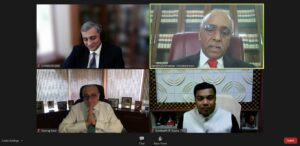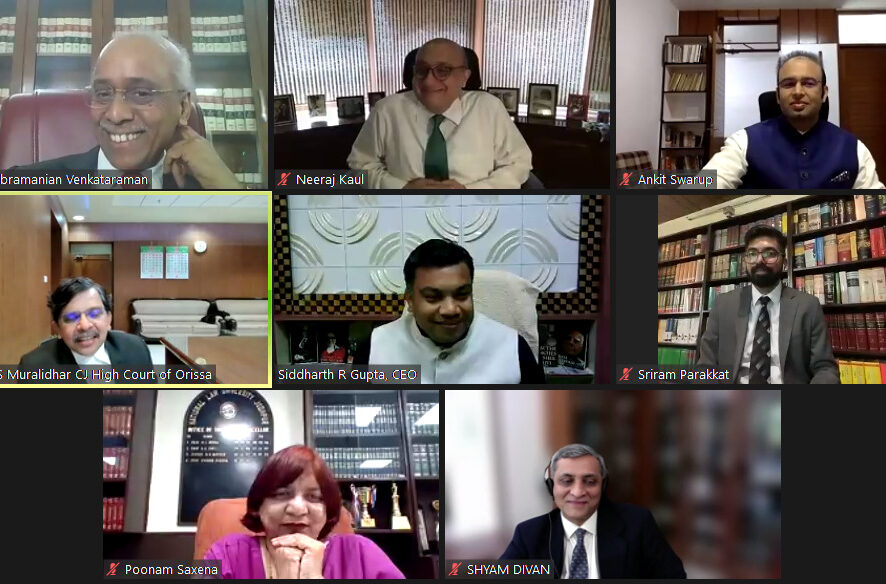CAN Foundation, in collaboration with National Law University, Jodhpur & Gujarat National Law University, Gandhinagar, hosted the ‘1st Justice HR Khanna Memorial National Symposium’ to commemorate the colossal persona of Late Justice HR Khanna. It was graced by various legal luminaries who delivered engaging addresses and shared profound opinions on a contemporarily significant theme – ‘Strengthening Doorstep Justice – Augmenting Access to Virtual Courts’. The Session was graced by Justice V Ramasubramanian (Judge, Supreme Court of India) as the Presiding Guest, Justice S Muralidhar (Chief Justice, Orissa High Court) as the Guest of Honor, and Mr. Neeraj Kishan Kaul & Mr. Shyam Divan, Senior Advocates, as panelists.
This article contains insightful excerpts from the addresses delivered by Justice V Ramasubramanian & Mr. Neeraj Kishan Kaul.

Justice V Ramasubramanian began the Keynote Address by commending the Esteemed Panel. He reminisced that, “At High Court level, Judges across the country used to see Justice Muralidhar as Steve Jobs of the Indian Judiciary, for his contributions to e-justice.”
He went on to highlight that Justice Muralidhar was one of the first Judges in India to initiate the process of e-filing in his courtroom and to take steps towards an environment-friendly Judiciary.
Proceeding to the topic of the discussion, he remarked that the Indian Judiciary had conceptualised the e-courts project in 2005 but it was only after the pandemic that the legal edifice could realise the true potential of Virtual Courts. He further opined:
“India is not alone to have awoken after the pandemic. Even the UNHRC recognized the need to switch over from physical mode to virtual mode only after the Covid-19 pandemic struck.”
He went on to elucidate the differences between Online and Virtual Courts, by asserting that in virtual hearings, judges, advocates and litigants need to be available for a hearing, whereas in online courts, the participants need not be present simultaneously.
Justice Ramasubramanian was of the opinion that India is not alone in its search for an online solution to an offline problem. He laid emphasis on the incumbent situation relating to Virtual Courts in jurisdictions such as that of the United States, United Kingdom, Ireland, Russia and China.
At this juncture, he discussed the Coronavirus Act, 2020 passed by the UK Parliament and the amendments introduced by this legislation. He applauded the McGlothlin Courtroom set up in the USA, best known for being the world’s most technologically advanced Court. Continuing on his discourse, he went on to refer to the Pexip Infinity technology, an application used in the Irish Courts that assists the Courts in deciding a large number of personal injury cases like accidental claims, assault, defamation etc. within a short span of time. Counting on the benefit of the aforementioned application, he elaborated that the unique feature of the technology was that participants can enter the meeting from other video services applications as well, which makes the entire process smooth. In his address, he also elucidated on the operation of video conferencing in the Russian legal system and also on the concept of global justice in China wherein the claims and hearings are conducted through artificial intelligence (commonly known as ‘Smart Courts’ in the Chinese community).
While concluding his Keynote Address, he shared a video of a real-life incident from the United States, wherein the presiding Judge of a Virtual Courtroom took immediate action to ensure that the witness appearing on the screen was not under any form of mental pressure after sensing unusual behaviour from the end of the witness.
Subsequent thereto, Mr. Neeraj Kishan Kaul, Senior Advocate, Supreme Court of India, commenced his address by sharing some lighter moments of the Virtual Court hearings. Coming back to the topic at hand, he stated:
“The Covid-19 induced lockdown of Courts has given us a flavour of the potential that technology holds to address the key concern of access to the judicial system and thereby justice.”
Proceeding with the discussion, he remarked that Virtual Courts are not a new concept for the Indian Judiciary. He elaborated that the e-courts project was conceptualized on the basis of the National Policy and Action Plan For Implementation of Information and Communications Technology in the Indian Judiciary way back in 2005. He also cited Justice DY Chandrachud’s dissenting opinion in Santhini v. Vijaya Venkatesh, (2018) 1 SCC 1, and highlighted how Justice Chandrachud favoured the use of technology and video conferencing even in the pre-pandemic era. He also referred to the Swapnil Tripathi case, (2018) 10 SCC 639 to emphasize the benefits of technology in the judicial system, particularly live streaming of Court proceedings.
Going deeper into the issue, he focussed on the benefits of modern artificial intelligence tools that, according to him:
“Will assist in improving the efficiency of our justice system through sophisticated and contextual automation of existing repetitive non-judicial tasks and functions to reduce pendency, expedite judicial adjudication and create more time for Judges to resolve complex cases.”
He went on to state that the current Covid-19 pandemic, as unfortunate as it is, has provided the much-needed momentum to undertake ICT integration into the Judiciary.
He expressed his dismay over the overwhelming pendency of matters at the stage of evidence in Trial Courts which kept increasing while the physical hearings were suspended. He was of the opinion that a nationwide standardised mechanism needs to be devised in order to equip Trial Courts to record evidence through video conferencing. He further noted that recording of evidence through video conferencing has been held to be an acceptable mode of recording by the Supreme Court, as it satisfies the objectives enshrined in the CrPC. He also remarked that even when evidence is recorded through video conferencing, it is recorded in the presence of the accused.
Mr. Kaul also elucidated on the various benefits of video conferencing and batted for a nationwide integrated mechanism so that the communication system can be improved. He expressed a hope that even when the physical functioning of Courts resumes, virtual courts would continue through the means of a hybrid functioning of Courts. He then expressed his opinion that there was a need for legislative banking for the temporary and long-term measures taken by the Judiciary towards the establishment of Virtual Courts.
Mr. Kaul highlighted that the issues caused due to Virtual Courts were caused because of digital illiteracy, the connectivity divide amongst the masses, and the lack of proper training for the various judicial officers. He also stated that the virtual hearing must supplement but not supplant physical hearings. He highlighted that in Virtual Courts, it is difficult for Courts to observe the demeanour of the witness and was of the opinion that the production of the accused through video conferencing can lead to instances where the accused is prevented from speaking freely because of external influences.
To conclude his address, he quoted Benjamin Cardozo, an American jurist, who once stated that, “New times demand new measures and new men in the field of law as elsewhere”. He further added that though Virtual Courts have been in vogue during the pandemic, they cannot be a substitute for physical hearings.
The Entire Session can be viewed HERE






